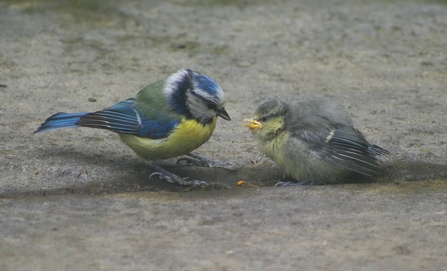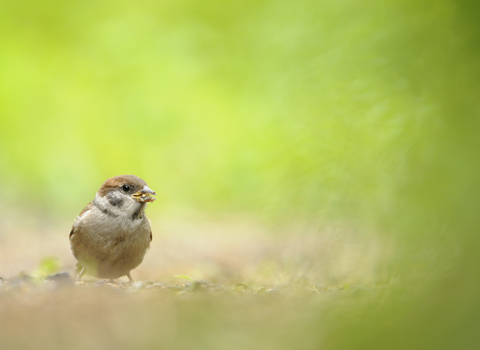Should you help a baby bird?
Parents will not abandon baby birds because they have been touched by humans. In most cases, a baby bird should be left alone; wildlife rescue organisations take in thousands of baby birds yearly, which while being well-intentioned rescue efforts are often more damaging than helpful. This page will help advise you on whether you should try to help a baby bird, what to do, and who to contact if you come across one. The Wildlife Trusts do not offer a general service for care and rehabilitation of wildlife, although some individual Trusts may offer local services. Before intervening, ask yourself the following questions:
Does it have feathers?
No feathers: It’s a nestling. Nestlings are very fragile and need immediate attention as they won't survive outside the nest for long. They should be (gently!) put back in the nest if you can see it, and the parents should return shortly. If you can’t see the nest, or if the parents do not return to the nest within an hour, contact a local wildlife rescue group.
Partially feathered: Birds that are still fluffy with short tails aren't as vulnerable, but will still be relying on their parents for food. It is likely their parents aren't far away
If it has feathers: It's a fledgling. It is normal for a fledgling to spend a few days on the ground and should be left alone unless they are in immediate danger. Its parents are normally keeping an eye nearby so you may want to watch and see if you can spot the parents, bearing in mind that they may be kept away by your presence.
What kind of bird is it?
There is no one rule for all baby birds, so it is important to know what kind of bird you are looking at to properly assess the situation - what's true for an owlet may not be for a sparrow chick. The advice on this page mainly refers to garden birds, but more information about other types of birds can be found on the Help Wildlife's website.
Some birds are under legal protection by the Wildlife and Countryside Act, but there are provisions allowing you to take a wild bird if it has been injured for the sole purpose of helping it recover before releasing it.
Is it hurt or in immediate danger?
It is a myth that its parents won't come back to a baby bird if it has been touched by a human. If you see a baby bird in a vulnerable position, you can move it to a safe, sheltered spot nearby e.g. under a hedge or onto a low branch if it is a fledgling, or back into its nest if it is a nestling. If it is in your garden, keep pets like cats and dogs indoors if possible, and if you are concerned about other garden visitors, you can keep a watch out from your window.
If it is obviously hurt, you may try to catch it and contact a local wildlife rescue organisation or vet. The younger it is and the fewer feathers it has, the sooner it will need expert attention. Birds bitten by cats are at risk of septicaemia (blood poisoning) and will die without swift antibiotic treatment within the first few hours. Contact a vet as soon as possible.
Can you see parents nearby?
If you return a nestling to its nest, the parents should return to it within an hour. Get in touch with a local wildlife rescue organisation or vet if there is no sign of the parents, and do not try to hand rear a chick yourself.
A fledgling's parents are normally keeping an eye nearby, and it should fly away in a couple of days when its wings are fully developed! If you are concerned that it may have been abandoned, or you find dead adult birds nearby, keep a watch from a distance for a couple of hours to see if they return, bearing in mind that its parents may be kept away by your presence.
Are you prepared to catch and handle the bird?
If you decide to catch the bird, take care. They have hollow, delicate bones, so improper handling can cause injury easily. Be firm, but gentle and be aware that they may bite, no matter how small and helpless they look! Below are some things to consider and prepare before attempting to help a baby bird.

It is normal for fledglings to spend a few days on the ground, and their parents are usually nearby keeping a watchful eye. © Gillian Day
Handling and care
Rushing in to save every lone baby bird you come across isn't recommended, and survival rates are low, but sometimes intervention can save a life. Having answered the questions above, if you have decided to intervene, here are some things to consider in preparing to catch, handle and care for the bird while you seek expert advice. Take care!
Baby birds should be handled very gently and will usually be more comfortable with their wings held against their bodies, feet supported. If possible, prepare the following before you attempt to rescue the bird:
- Prepare a container for the bird before catching it if possible - something like an ice cream tub or a shoebox lined with tissues will usually be ok
- Remember to provide air holes if you need to cover the box
- Put the bird somewhere quiet and warm - a nestling should be warm to the touch, but not hot or panting
- Prepare a water bottle wrapped in a towel as a source of heat placed next to, under, or inside the box, with space for the bird to move away if it wants to
Do not offer food or water, or try to hand rear the bird unless you have directly been instructed to do so by an expert. They have very specialised diets and it is very easy to drown a bird by trying to give it water.
What to do next
If you are unsure about what to do, or are unable to get the casualty specialist care within an hour, speak to an animal welfare organisation like the RSPCA for advice. Wildlife rescue services usually can't offer pick up, so you will likely need to transport the bird yourself. Make sure you wash your hands well after handling any animal!
Vets aren't obliged to treat wildlife for free, and typically aren't trained in the care of wildlife, so it is a good idea to call around local practices before visiting, and find out if your vet has links with local wildlife rescue groups to make sure the animal is taken care of after being treated.
The RSPCA (SSPCA for Scotland, or the USPCA for Northern Ireland) and Help Wildlife's pages carry more detailed advice on what to do with injured birds and other wildlife. Help Wildlife also have a useful map to help find your local wildlife rescue service.

